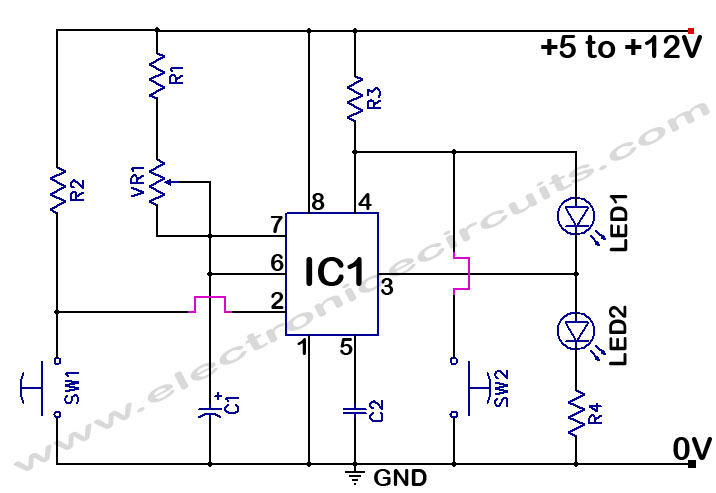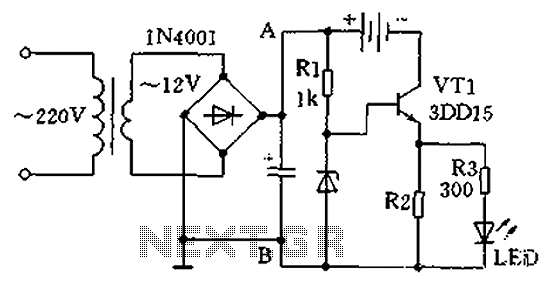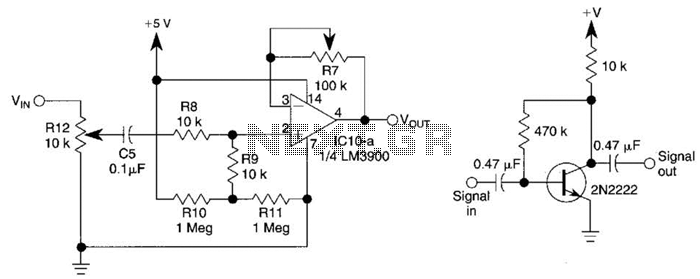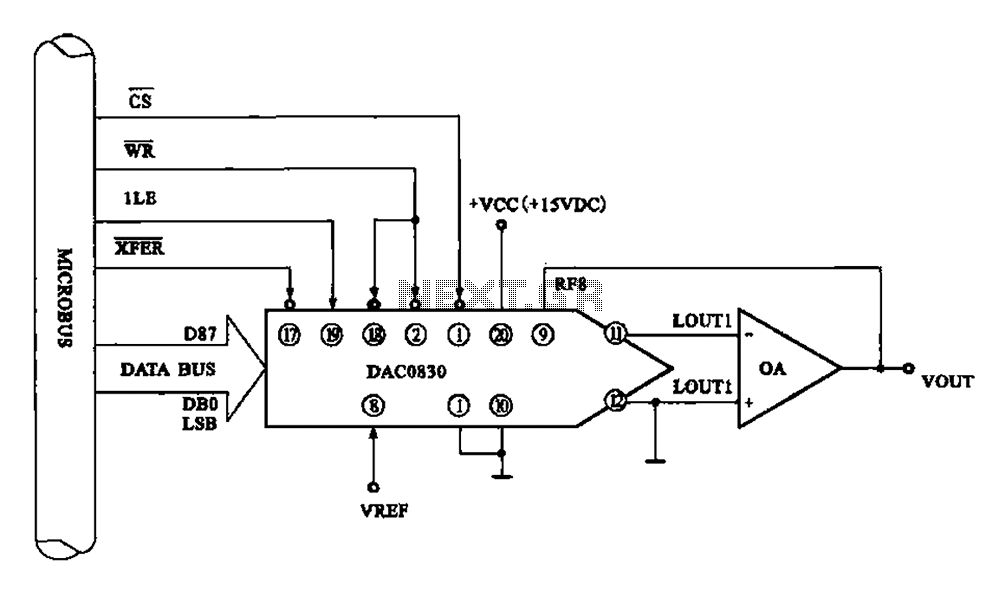
27MHz CB Amplifier Circuit
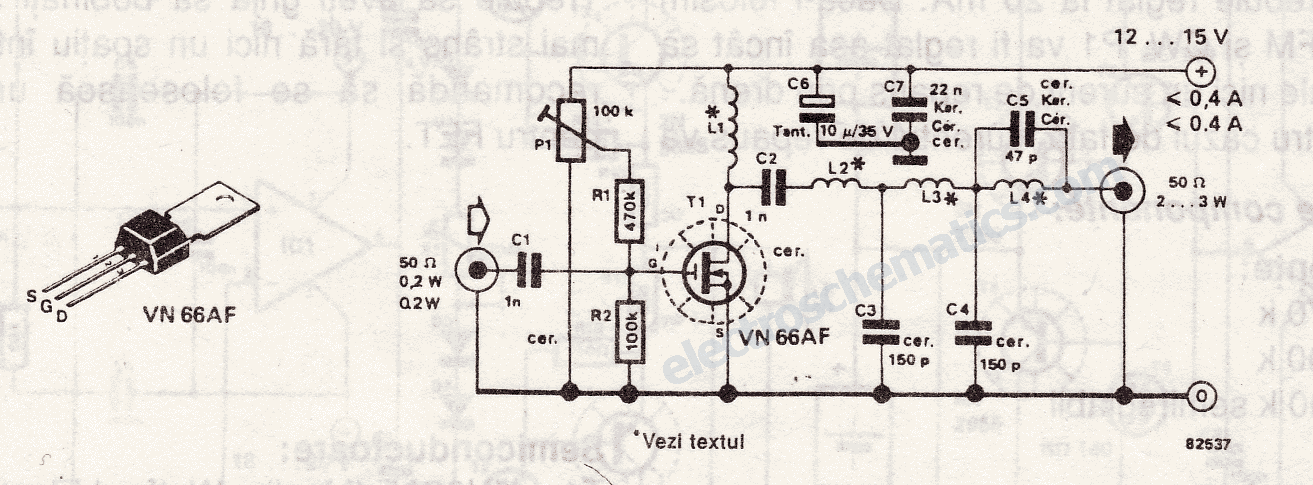
The 10-meter 27MHz continuous wave (CW) radio amplifier is equipped with the VN66AF transistor produced by Siliconix, which offers several advantages: it is inexpensive, provides excellent dielectric insulation, and has high gain. The VN66AF is utilized as an RF amplifier for the 10-meter band (26-30 MHz). For linear applications such as amplitude modulation (AM) and single sideband (SSB), the gate current of the VMOS FET must be adjusted to 20mA using potentiometer P1. If the amplifier is intended for frequency modulation (FM) and CW operation, P1 should be adjusted to ensure there is no current flowing to the FET gate. In this configuration, the steady-state current ranges from 200mA to 300mA.
The 10-meter 27MHz CW radio amplifier circuit utilizes the VN66AF transistor, which is a vertical N-channel MOSFET designed for efficient RF applications. The transistor's high gain characteristics make it suitable for amplifying weak radio signals in the 26-30 MHz frequency range, which is critical for effective communication in amateur radio.
The circuit design incorporates a biasing network to ensure the VN66AF operates in its optimal region, allowing for linear amplification when required. For applications involving AM and SSB, the gate current must be precisely set to 20mA. This is achieved through the adjustment of potentiometer P1, which allows for fine-tuning of the gate voltage, ensuring the transistor remains in the active region for linear amplification.
When configuring the amplifier for FM and CW modes, it is essential to adjust P1 to eliminate any gate current. This adjustment is crucial as it prevents distortion and ensures that the amplifier operates efficiently in these modes. The steady-state current, which is the current flowing through the transistor when it is in operation, is maintained between 200mA and 300mA. This range is critical for achieving the desired output power while preventing overheating and ensuring reliability.
The circuit should also include appropriate bypass capacitors to filter out noise and stabilize the power supply. Additionally, an output matching network may be necessary to ensure maximum power transfer to the antenna, optimizing the amplifier's performance. Proper heat sinking should be employed to dissipate heat generated by the VN66AF during operation, safeguarding the transistor from thermal damage.
In summary, the 10-meter 27MHz CW radio amplifier utilizing the VN66AF transistor is an effective solution for amateur radio applications, offering flexibility for various modulation types while ensuring reliable performance through careful biasing and current management.The 10 meters 27MHz CW radio amplifier is equiped with VN66AF transistor produced by Siliconix wich has some advantages: its cheap, great dielectric insulation and high gain. Here we use VN66AF as an rf amplifier for 10m band (26 30 MHz ). For linear applications (AM and BLU) the VMOS FET gate current has to be 20mA adjusted with P1. If we wan t to use this 10m rf amplifier for FM and CW adjust P1 so there is no current to FET gate. In our case the repose current ( steady current ) is 200mA to 300mA. 🔗 External reference
The 10-meter 27MHz CW radio amplifier circuit utilizes the VN66AF transistor, which is a vertical N-channel MOSFET designed for efficient RF applications. The transistor's high gain characteristics make it suitable for amplifying weak radio signals in the 26-30 MHz frequency range, which is critical for effective communication in amateur radio.
The circuit design incorporates a biasing network to ensure the VN66AF operates in its optimal region, allowing for linear amplification when required. For applications involving AM and SSB, the gate current must be precisely set to 20mA. This is achieved through the adjustment of potentiometer P1, which allows for fine-tuning of the gate voltage, ensuring the transistor remains in the active region for linear amplification.
When configuring the amplifier for FM and CW modes, it is essential to adjust P1 to eliminate any gate current. This adjustment is crucial as it prevents distortion and ensures that the amplifier operates efficiently in these modes. The steady-state current, which is the current flowing through the transistor when it is in operation, is maintained between 200mA and 300mA. This range is critical for achieving the desired output power while preventing overheating and ensuring reliability.
The circuit should also include appropriate bypass capacitors to filter out noise and stabilize the power supply. Additionally, an output matching network may be necessary to ensure maximum power transfer to the antenna, optimizing the amplifier's performance. Proper heat sinking should be employed to dissipate heat generated by the VN66AF during operation, safeguarding the transistor from thermal damage.
In summary, the 10-meter 27MHz CW radio amplifier utilizing the VN66AF transistor is an effective solution for amateur radio applications, offering flexibility for various modulation types while ensuring reliable performance through careful biasing and current management.The 10 meters 27MHz CW radio amplifier is equiped with VN66AF transistor produced by Siliconix wich has some advantages: its cheap, great dielectric insulation and high gain. Here we use VN66AF as an rf amplifier for 10m band (26 30 MHz ). For linear applications (AM and BLU) the VMOS FET gate current has to be 20mA adjusted with P1. If we wan t to use this 10m rf amplifier for FM and CW adjust P1 so there is no current to FET gate. In our case the repose current ( steady current ) is 200mA to 300mA. 🔗 External reference


